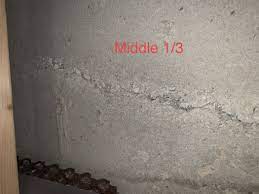Hi all. The pics attached are a pier and beam foundation with concrete perimeter. Can someone tell me how this would be repaired? There’s also what look like rusty nails along the foundation, though they’re not sharp. Can anyone tell what these are for? Thanks for any replies!
The “rusty nails” are form ties. They are a what are used to hold the concrete forms in place while the concrete is being poured. After the forms are removed, those ties are snapped off flush with the concrete. If not covered with paint, some form of damp proofing, or parge coating, they will rust when left exposed to the elements since they are steel. Those ties need to be covered and/or protected from the elements.
As far as the cracks, they look like cold joints from hear. Google search “concrete cold joint” for explanation. There are many “remedies” or types of repairs that can be done but some cost a lot and don’t do much. Regardless, any repairs done should be on the exterior and not the inside. If the cracks don’t go all the way through the wall, then stripping the paint and patch with some form of no shrink grout being sure to use a bonding agent. IF they do go all the way through, call a foundation contractor.
A call to a local Mason to come out, evaluate, quote, and make repairs to current standards as required.
Those don’t look like cold joints to me. They look like chipping/cracking concrete - as in more surface or definitive cracks. A cold joint is just a separate pour, usually when the first one has dried slightly. I grabbed these pics off Google.

Looks like stress cracking to me. That material is failing in my opinion. I just have no idea the consequence or the load it is carrying.
Thanks Brian. The listing for this house shows that it’s a pier and beam built in 1958. I do believe that concrete is just a skirting. Will this have rebar?
Appears to be so from here.
This makes more sense - that it’s just a thin coat. At least that explains why it’s cracking. I suppose they could have put some rebar in it. I’d probably just write it up as “cracking and failing” but, of course, it’s interesting for us to know the “why”.
Fairly common in older applications to see a parge coat applied to plywood skirting, thus is easily damaged.
Yeah, the rebar is what’s throwing me here. Would they put it in these coatings?
I don’t see why. It’s non-structural.
I think you’re right about this. I’ll find out soon enough. Thanks for your reply.
No pictures from Crawlspace side? Could help with an evaluation.
No more pictures, actually. I was thinking of making an offer today, but my wife decided to back out. We do have another house we will see next week, so hoping for the best. Thanks for your reply.
Not necessarily. There are at least 3 in this picture, hard to see but they are there:
This was obviously from a commercial job where more than likely a vibrator was used, consolidating the concrete where the different lifts were poured, making the joint hard to see.
Here’s another example from InspectApedia (I added the arrows and text):
Cover this with some damp proofing or paint and nobody would be the wiser. Give it 40+ years exposed to the elements and a different story could be told…
Another example. I took this one myself while waiting to deliver a load. The only way to know it’s there is the color differential. Different loads poured at different slumps (the lower area was poured at a higher slump, or considerably wetter), with some gap between them being placed…
Regardless of what everyone’s thoughts are on the pictures presented by the OP, we were not there to see the whole thing, so it’s all speculation.
.
Thus my first post…
AGREED Jeffry. ![]()
call a foundation contractor.






